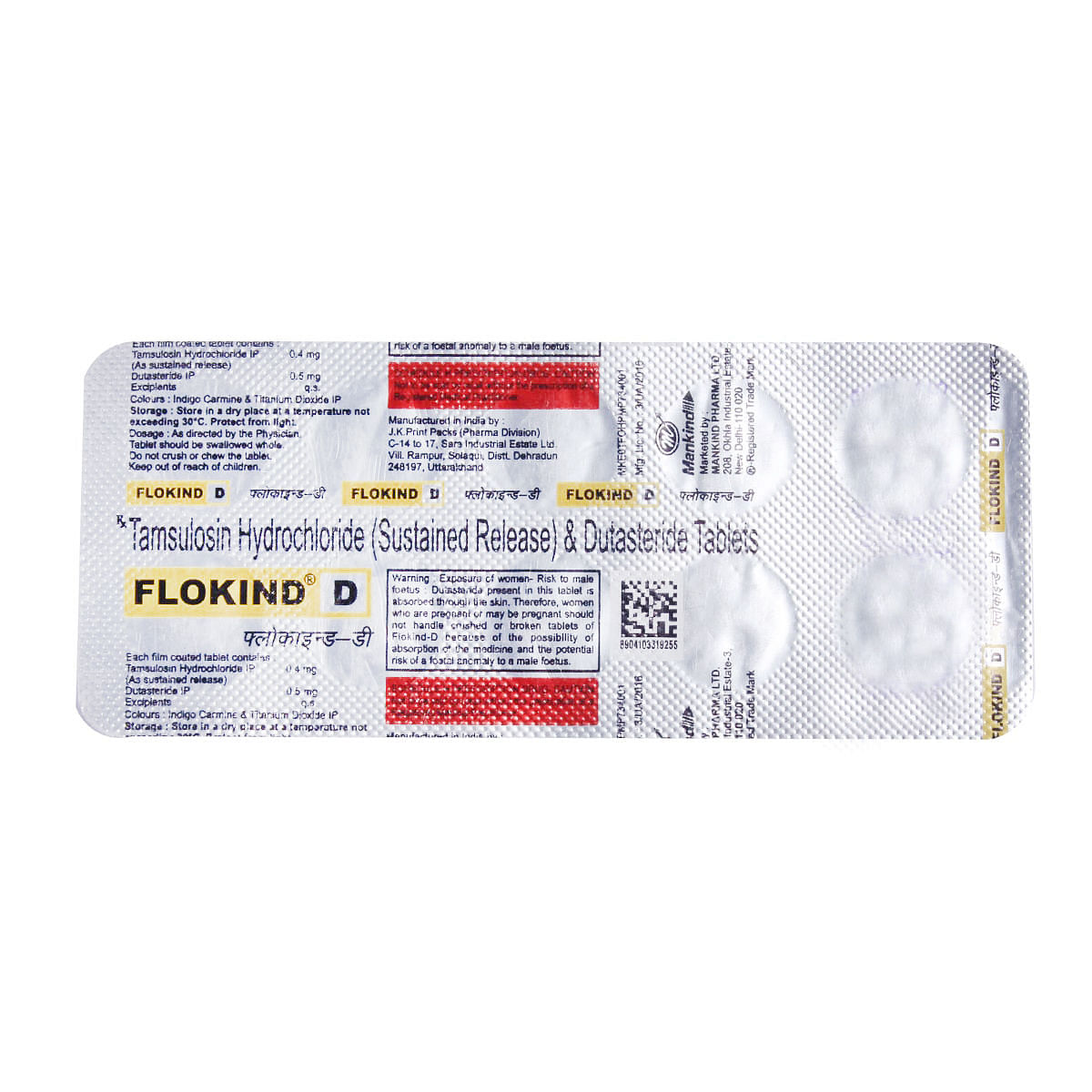
Flonis-D Tablet
Manufacturer
Acekinetics Healthcare Pvt Ltd
Salt Composition
Tamsulosin (0.4mg) + Dutasteride (0.5mg)
Key Information
Short Description
Flonis-D Tablet is a combination of two medicines that work in different ways to treat men with an enlarged prostate gland, relieving symptoms such as difficulty urinating or needing to go to the toilet more often.
Dosage Form
Tablet
Introduction
Flonis-D Tablet may be taken with or without food but it should be taken at the same time each day. Your doctor will prescribe the dose most suitable for you. To gain the most benefit and to treat your symptoms effectively, you should not miss doses, even if you feel well. It may take up to 4 weeks to notice an improvement in the symptoms but keep taking them regularly. Tell your doctor if your symptoms do not improve after 4 weeks or if they get worse.
Directions for Use
Take this medicine in the dose and duration as advised by your doctor. Swallow it as a whole. Do not chew, crush or break it. Flonis-D Tablet may be taken with or without food, but it is better to take it at a fixed time.
Safety Information
Side Effects
It may cause difficulty achieving or maintaining an erection (impotence), decreased sex drive, and ejaculation disorders such as decreased amount of semen produced or decreased sperm count.
Alcohol Warning
Flonis-D Tablet may cause excessive drowsiness with alcohol.
Breastfeeding Warning
Information regarding the use of Flonis-D Tablet during breastfeeding is not available. Please consult your doctor.
Pregnancy Warning
Information regarding the use of Flonis-D Tablet during pregnancy is not available. Please consult your doctor.
How it works
Flonis-D Tablet is a combination of two medicines: Tamsulosin and Dutasteride, which relieves the symptoms of benign prostatic hyperplasia. Tamsulosin is an alpha-blocker, which works by relaxing the muscle around the bladder exit and prostate gland so as to allow easy passage of urine. Dutasteride is a 5-alpha-reductase inhibitor, which helps in shrinking the prostate gland by decreasing the level of the hormone which helps the prostate gland grow.
Quick Tips
You have been prescribed Flonis-D Tablet to relieve the symptoms of benign prostatic hyperplasia (BPH). Take it approximately 30 minutes after the same meal each day. Flonis-D Tablet may cause dizziness or blurring of vision. Do not drive or do anything requiring concentration until you know how it affects you. Rise slowly if you have been sitting or lying down. If you are scheduled to undergo an eye surgery due to cataract or glaucoma, inform your eye doctor about the usage of Flonis-D Tablet.
Related Medicines

Flokind-D Tablet

Flotam D 0.4mg/0.5mg Tablet

Psa Fit 0.4mg/0.5mg Tablet

Urisped D Tablet

Tosin D 0.4mg/0.5mg Tablet

Uromag D 0.4mg/0.5mg Tablet

Tamdart 0.4mg/0.5mg Tablet

Tam-D 0.4mg/0.5mg Tablet

Tamiflo D 0.4mg/0.5mg Tablet

Tamsorid D 0.4mg/0.5mg Tablet
Frequently asked questions
Is Flonis-D Tablet effective?
Yes, Flonis-D Tablet is an effective treatment for your condition if used as directed by your doctor. It's essential to continue taking the medication in the prescribed dose and duration to achieve optimal results. Stopping or reducing the dosage too early may lead to worsening symptoms.
Can the use of Flonis-D Tablet cause dizziness?
Yes, Flonis-D Tablet can cause dizziness as a side effect. This is due to its active ingredient Tamsulosin, which can cause orthostatic hypotension, leading to sudden falls in blood pressure while changing positions from lying down to sitting or standing. If you experience dizziness or lightheadedness, it's crucial to rest and avoid driving or operating machinery until you feel better.
What are the cautions associated with the use of Flonis-D Tablet?
The use of Flonis-D Tablet is not recommended for men under 18 years old as it may affect normal male reproductive development. Additionally, it's contraindicated in women who are pregnant or of childbearing potential. Pregnant women should also avoid handling Flonis-D Tablet to prevent any harm to the fetus through skin absorption.
Is Flonis-D Tablet safe?
Yes, Flonis-D Tablet is a safe medication when used as directed by your doctor. It's essential to take it exactly as prescribed and inform your doctor if you experience any side effects.
Can I take a higher than the recommended dose of this medicine?
No, taking more than the recommended dose of Flonis-D Tablet can increase the risk of adverse effects. Always follow your doctor's instructions and stick to the prescribed dosage.
What is the storage condition for Flonis-D Tablet?
To maintain the effectiveness and safety of Flonis-D Tablet, store it in its original container or packaging tightly closed. Dispose of any unused medication according to the package instructions, and ensure that it is not accessible to children, pets, or other individuals.
Can the use of Flonis-D Tablet cause ejaculation problems?
Yes, some men may experience retrograde ejaculation (when semen does not exit the body but instead enters the bladder) or reduced ejaculation volume while taking Flonis-D Tablet. However, these side effects are generally harmless and typically resolve once you stop using the medication.
Can the use of Flonis-D Tablet cause priapism?
Yes, Flonis-D Tablet can cause a rare but serious side effect known as priapism (a prolonged, painful erection unrelated to sexual activity). If you experience this symptom, seek immediate medical attention to avoid potential long-term complications.
Can the use of Flonis-D Tablet have any impact on my cataract surgery?
Yes, using Flonis-D Tablet can cause floppy iris syndrome. This condition can lead to an unexpected constriction of the pupil during cataract surgery, which may affect surgical outcomes. Inform your eye doctor about your medication usage before undergoing surgery.
Apart from taking medicines, what should I do to manage my prostate symptoms?
In addition to following your doctor's medication regimen, consider simple lifestyle adjustments to help manage your prostate symptoms. This includes urinating when you first feel the urge, avoiding straining or pushing during urination, and reducing fluid intake before bedtime or engaging in activities that worsen urinary symptoms.


